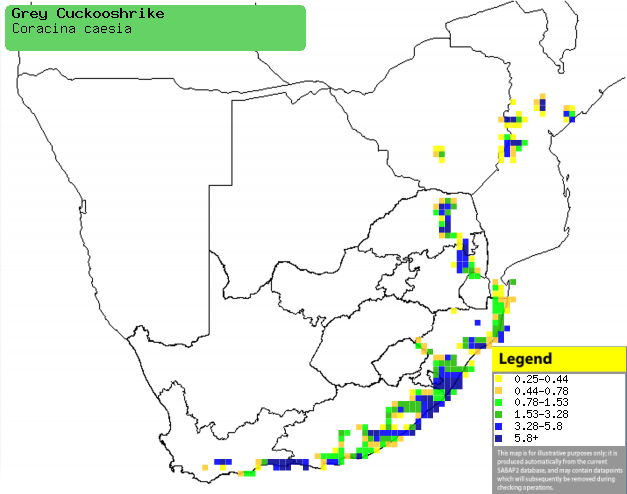|
Coracina caesia (Grey
Cuckooshrike)
Bloukatakoeroe [Afrikaans];
Umsimpofu, Usinga [Xhosa]; iKlebedwane [Zulu]; Bosrupsvogel [Dutch];
Échenilleur gris [French]; Grauer raupenfänger, Waldraupenfänger [German];
Lagarteiro-cinzento [Portuguese]
Life
> Eukaryotes >
Opisthokonta
> Metazoa (animals) >
Bilateria >
Deuterostomia > Chordata >
Craniata > Vertebrata (vertebrates) > Gnathostomata (jawed
vertebrates) > Teleostomi (teleost fish) > Osteichthyes (bony fish) > Class:
Sarcopterygii (lobe-finned
fish) > Stegocephalia (terrestrial
vertebrates) > Tetrapoda
(four-legged vertebrates) > Reptiliomorpha > Amniota >
Reptilia (reptiles) >
Romeriida > Diapsida > Archosauromorpha > Archosauria >
Dinosauria
(dinosaurs) > Saurischia > Theropoda (bipedal predatory dinosaurs) >
Coelurosauria > Maniraptora > Aves
(birds) > Order: Passeriformes
> Family: Campephagidae
Distribution and habitat
Occurs in isolated populations across sub-Saharan Africa,
with one of the largest in South Africa, from eastern Limpopo Province along the
coast to the Western Cape. It also occupies Zimbabwe's eastern highlands
bordering on Mozambique. It is generally uncommon and usually found in the upper
canopy of evergreen and coastal forest, but it may also occur in old pine
plantations and tall stands of trees in coastal towns.
|
 |
|
Distribution of Grey cuckooshrike in southern Africa,
based on statistical smoothing of the records from first SA Bird Atlas
Project (©
Animal Demography unit, University of
Cape Town; smoothing by Birgit Erni and Francesca Little). Colours range
from dark blue (most common) through to yellow (least common).
See here for the latest distribution
from the SABAP2. |
Food
It is insectivorous, mainly eating caterpillars and doing
most of its foraging in the upper canopy of the forest, slowly creeping though
the foliage. Occasionally it peers upwards, looking for insects or spiders on
the underside of leaves. Once it spots something it flies upwards, grabs the
prey and then returns to its perch to feed. The following food items have been
recorded in its diet:
Breeding
- The nest is shallow bowl built of old-man's beard lichen (Usnea)
cemented with spider web and placed either on a thick branch or in the fork
of a tree, usually on the forest edge.
- Egg-laying season peaks from November-December.
- It lays 1-2 eggs, which are incubated both sexes. The chicks remain with
their parents into the next breeding season.
Threats
Not threatened, in fact seemingly undisturbed by humans.
References
-
Hockey PAR, Dean WRJ and Ryan PG 2005. Roberts
- Birds of southern Africa, VIIth ed. The Trustees of the John Voelcker
Bird Book Fund, Cape Town.
|
